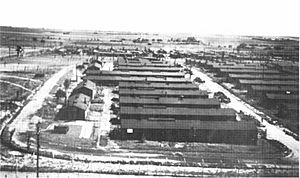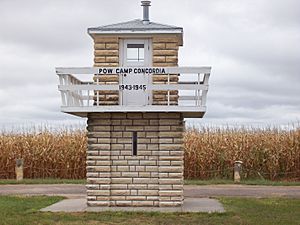Camp Concordia facts for kids
Camp Concordia was a special camp for prisoners of war during World War II. It was open from 1943 to 1945. The camp was located near Concordia, Kansas. Most of the prisoners held here were German soldiers. They had been captured during battles in Africa.
Camp Concordia was the biggest POW camp in Kansas. It held more than 4,000 prisoners. The camp had about 300 buildings. Around 800 U.S. soldiers worked there as staff.
Contents
Life at Camp Concordia
Prisoners arrived at Camp Concordia by train. The U.S. authorities thought the soldiers could help with farm work. Soon after arriving, the German prisoners began working with local farmers.
Interactions Among Prisoners
There were a few serious incidents between prisoners. Some prisoners were believed to be Gestapo agents. When clear proof was found, the prisoners involved were tried. They were then sent to a federal prison at Leavenworth.
Interactions with Locals
"Problems between the prisoners and local people were rare," said Lowell May. He is the president of the camp's preservation society. "In fact, some friendships even formed." Only a few prisoners tried to escape, but none succeeded. Life at the camp was much easier than fighting in Europe. Prisoners played outdoor sports and listened to music. They could also take classes from the University of Kansas.
Famous Prisoners
Some notable people were held at Camp Concordia:
- Karl Bracher, who became a famous historian.
- Harald Deilmann, who became a well-known architect and author.
- Reinhard Mohn, who later owned a huge media company called Bertelsmann AG.
Returning Home
The prisoners went back to Germany in the autumn of 1945. Some of them had good memories of their time in Kansas. Franz Kramer, from Gundelfingen, Germany, said: "We had no reason to complain about the American authorities. The prisoners felt they were treated well. We learned a bit about the American way of life and saw part of this huge country."
What Happened Later
After the POW camp closed, some buildings were sold. In 1947, the City of Concordia bought 166.7 acres of the camp land. They wanted to make a park and move the Cloud County fairgrounds there. But the park plans never happened. The city eventually sold many buildings and land. One building, T-9, was used for many things. It was a skating rink, a hog farm, and a canoe factory. In the 1960s, it stored items for a horse racetrack called Thundercloud Park.
Camp Concordia Today
A few parts of the camp still stand today. These include a prison warehouse used for storage and an officers club. A guard tower has also been fixed up. Only the guard tower is easy for the public to visit. Most of the land is now used for farming. Some houses have also been built there. The original guard house is still there and has been restored. Even today, former prisoners and their families still write to people in Concordia.
Records from the camp are kept at the Cloud County Historical Museum in Concordia. The museum also displays many interesting items from Camp Concordia. These include paintings made by the prisoners themselves.



